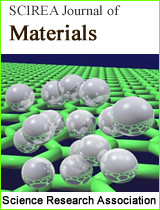Disintegration Properties and Drug Release Profiles of Chondroitin Sulfate Films
DOI: 210 Downloads 14968 Views
Author(s)
Abstract
Film dosage form (FD) prepared using water-soluble polymers is an excellent technique by which drugs can be delivered to local disease sites. In this study, FD was prepared with the sodium salt of chondroitin sulfate (CHS), a natural polysaccharide, by the casting method. The disintegration profile of FD was assessed and the dissolution profile of the model drug from the dosage form was investigated. FDs containing atropine sulfate were prepared by using 4−6% of CHS. When the FDs were brought in contact with physiological saline, they swelled quickly and disintegrated resulting in CHS release into the medium. The model drug dissolved immediately from the FDs and almost the entire amount of the drug incorporated in the FD was dissolved after 5 min. FD prepared with CHS is an attractive dosage form that can be used for local drug delivery.
Keywords
Sodium Chondroitin Sulfate, Film Dosage Form, Film Disintegration, Atropine Sulfate, Drug Release Profile
Cite this paper
Yoshifumi Murata, Yukako Maejima, Chieko Maida, Kyoko Kofuji,
Disintegration Properties and Drug Release Profiles of Chondroitin Sulfate Films
, SCIREA Journal of Materials.
Volume 4, Issue 2, April 2019 | PP. 32-40.
References
| [ 1 ] | N. Volpi, “Chondroitin sulfate safety and quality,” Molecules, vol. 24, no, 8, pii: E1447, 2019. |
| [ 2 ] | C. T. Jr. Vangsness, W. Spiker, and J. Erickson, “A review of evidence-based medicine for glucosamine and chondroitin sulfate use in knee osteoarthritis,” Arthroscopy, vol. 25, no. 1, pp. 86-94, 2009. |
| [ 3 ] | Y. Henrotin, M. Marty, and A. Mobasheri, “What is the current status of chondroitin sulfate and glucosamine for the treatment of knee osteoarthritis?” Maturitas, vol. 78, no. 3, pp. 184-187, 2014. |
| [ 4 ] | O. Bruyère, R. D. Altman, and J. Y. Reginster, “Efficacy and safety of glucosamine sulfate in the management of osteoarthritis: Evidence from real-life setting trials and surveys,” Seminars in Arthritis and Rheumatism, vol. 45(4 Suppl), pp. S12-17, 2016. |
| [ 5 ] | M. B. Limberg, C. McCaa, G. E. Kissling, and H. E. Kaufman, “Topical application of hyaluronic acid and chondroitin sulfate in the treatment of dry eyes,” American Journal of Ophthalmology, vol. 103, no. 2, pp. 194-197, 1987. |
| [ 6 ] | A. L. Pérez-Balbuena, J. C, Ochoa-Tabares, S. Belalcazar-Rey, C. Urzúa-Salinas, L. R. Saucedo-Rodríguez, R. Velasco-Ramos, R. G. Suárez-Sánchez, A. D. Rodríguez-Carrizalez, and A. A. Oregón-Miranda, “Efficacy of a fixed combination of 0.09 % xanthan gum/0.1 % chondroitin sulfate preservative free vs polyethylene glycol/propylene glycol in subjects with dry eye disease: a multicenter randomized controlled trial,” BMC Ophthalmology, vol. 16, no. 1, p. 164, 2016. |
| [ 7 ] | G. Kaur, V. Rana, S. Jain, and A. K. Tiwary, “Colon delivery of budesonide: evaluation of chitosan-chondroitin sulfate interpolymer complex,” AAPS PharmSciTech, vol. 11, no. 1, pp. 36-45, 2010. |
| [ 8 ] | R. Bagari, D. Bansal, A. Gulbake, A. Jain, V. Soni, and S. K. Jain, “Chondroitin sulfate functionalized liposomes for solid tumor targeting,” Journal of Drug Targeting, vol. 19, no. 4, pp. 251-257, 2011. |
| [ 9 ] | X. Li, Y. Lan, Y. He, Y. Liu, H. Luo, H. Yu, N. Song, S. Ren, T. Liu, C. Hao, Y. Guo, and L. Zhang, “Heparan sulfate and chondroitin sulfate glycosaminoglycans are targeted by bleomycin in cancer cells,” Cellular Physiology and Biochemistry, vol. 43, no. 3, pp. 1220-1234, 2017. |
| [ 10 ] | A. A. Kassem, D. A. Issa, G. S. Kotry, and R. M. Farid, “Thiolated alginate-based multiple layer mucoadhesive films of metformin forintra-pocket local delivery: in vitro characterization and clinical assessment,” Drug Development and Industrial Pharmacy, vol. 43, no. 1, pp. 120-131, 2017. |
| [ 11 ] | M. Kilicarslan, M. Ilhan, O. Inal, and K. Orhan, “Preparation and evaluation of clindamycin phosphate loaded chitosan/alginate polyelectrolyte complex film as mucoadhesive drug delivery system for periodontal therapy,” European Journal of Pharmaceutical Sciences, vol. 123, pp. 441-451, 2018. |
| [ 12 ] | A. Shahzad, A. Khan, Z. Afzal, M. F. Umer, J. Khan, and G. M. Khan, “Formulation development and characterization of cefazolin nanoparticles-loaded cross-linked films of sodium alginate and pectin as wound dressings,” International Journal of Biological Macromolecules, vol. 124, pp. 255-269, 2019. |
| [ 13 ] | Y. Murata, M. Kokubo, M. Miyashita, and S. Kawashima, “Derivation of hydroxamic acid from pectin and its applications in colorimetric determination,” Chemical and Pharmaceutical Bulletin, vol. 51, no. 7, pp. 897-898, 2003. |
| [ 14 ] | Y. Murata, H. Sakano, C. Maida, and K. Kofuji, “Disintegration properties and drug release profiles of sodium alginate films modified with additives,” Research & Development in Material Science, vol. 2, no. 1, pp. 529-532, 2017. |
| [ 15 ] | Y. Murata, C. Maida, and K. Kofuji, “Drug release profiles and disintegration properties of pectin films,” Materials, vol. 12, no. 3, pp. 355-361, 2019. |
| [ 16 ] | X. Jia X, Q. Liu, Y. Wei, B. Chen, Y. Chu, and J. Zhang, “Simultaneously determination of atropine sulphate, diphenhydramine hydrochloride, capsaicin and dihydrocapsaicin in pain-relieving plaster for arthritis by RP-HPLC,” Zhongguo Zhong Yao Za Zhi, vol. 35, no. 21, pp. 2838-2841, 2010. |

